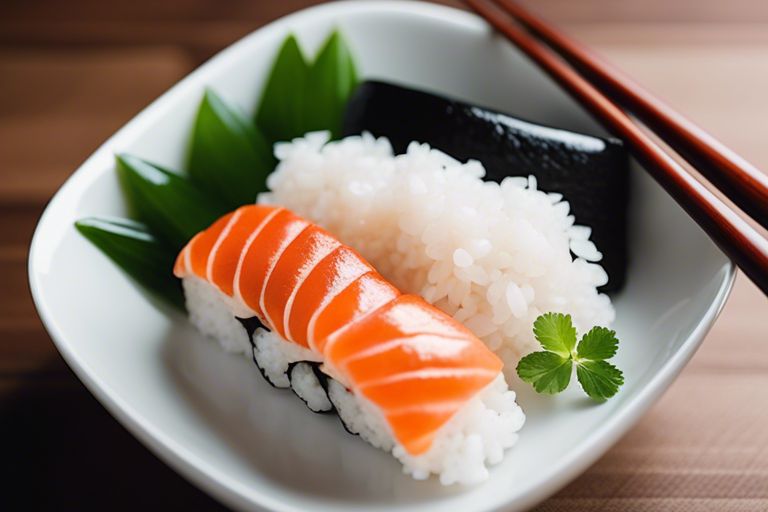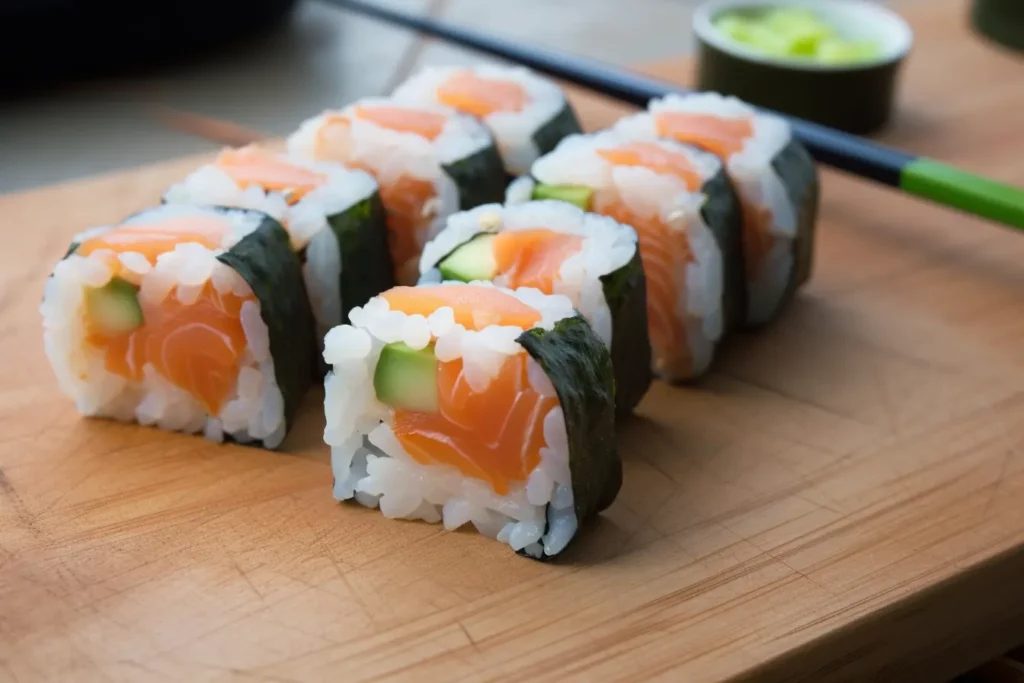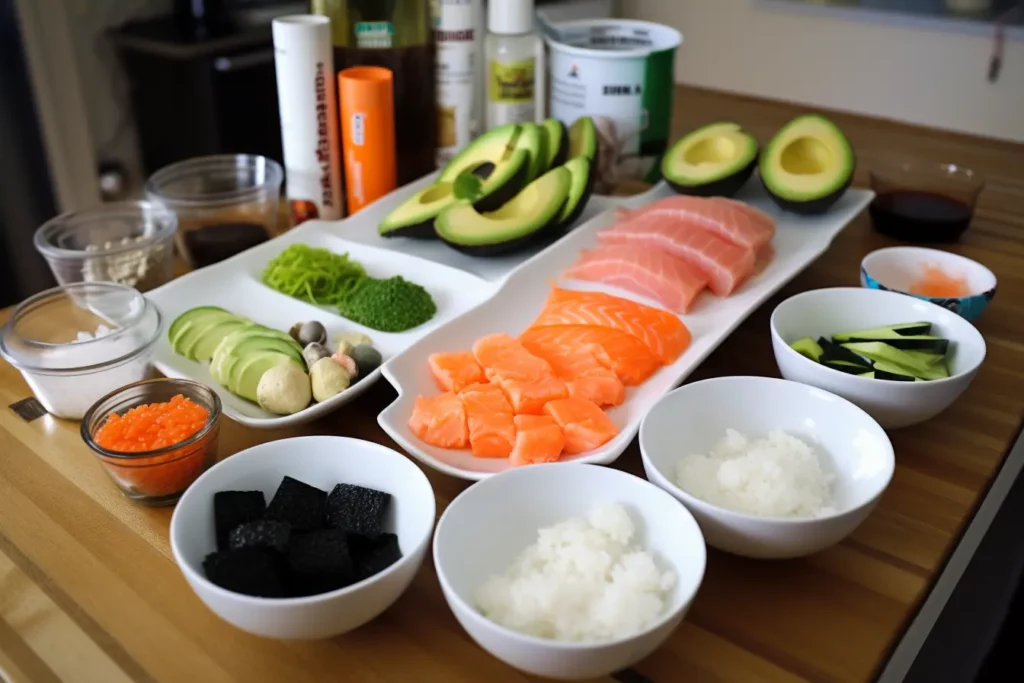Introduction
Welcome to my blog post about rice vinegar and sushi rice. In this article, I’m going to take a closer look at the basics and preparation of these two essential ingredients of Japanese cuisine.
Welcome to the world of rice vinegar and sushi rice
Before we dive deeper, I would like to welcome you to the fascinating world of rice vinegar and sushi rice. These two ingredients play a crucial role in the preparation of sushi and are closely related.
They give sushi its characteristic taste and special consistency. Together, they ensure that every sushi becomes a unique culinary experience.
Why this combination is so special
There are many reasons why the combination of rice vinegar and sushi rice is so special. On the one hand, the rice vinegar gives sushi rice its unmistakable taste and pleasant acidity. On the other hand, the special stickiness of the sushi rice in combination with the rice vinegar ensures that the individual sushi rolls are optimally malleable and have the perfect consistency when consumed.
The harmonious combination of rice vinegar and sushi rice creates a taste experience that is second to none and forms the basis for the popular Japanese dish.
Rice Vinegar: A Culinary Voyage of Discovery
Rice vinegar, also known as rice vinegar or Japanese rice vinegar, is an important ingredient in Japanese and Asian cuisine. Its unique aroma and multiple uses make it an indispensable ingredient in many dishes, especially sushi and other rice specialties.
In this section, I will go into more detail about the history and production of rice vinegar, introduce different types of rice vinegar as well as their characteristics, and give tips on how to use rice vinegar in the kitchen.
History and production of rice vinegar
The history of rice vinegar dates back centuries and is closely linked to Japanese and Asian culture. Rice vinegar was originally developed as a method of preserving rice, but over time it became an important ingredient in the kitchen.
Rice vinegar is made by fermenting rice, water, and sometimes other ingredients such as sugar or malt. This process can vary depending on the type of rice vinegar and regional traditions, but ultimately results in a unique and versatile vinegar product.
Different types of rice vinegar and their characteristics
There are several types of rice vinegar, including the clear rice vinegar, red rice vinegar, and black rice vinegar. Each species has its own characteristic characteristics, which differ in taste, color and intended use.
Clear rice vinegar, also known as “young” rice vinegar, has a mild and refreshing flavor and works well in salad dressings and marinades. Red rice vinegar, on the other hand, is slightly stronger in flavor and is commonly used in sauces and broths, while black rice vinegar has a rich and deep flavor and is often used in stews and stews.
Sushi Rice: The Heart of Sushi
The sushi rice, also known as shari, is the central element of sushi. The quality and preparation of the rice have a decisive influence on the taste and consistency of the sushi. That’s why it’s important to choose the sushi rice carefully and prepare it properly.
Choosing the Right Type of Rice
Choosing the right type of rice is crucial when preparing sushi rice. It is recommended to use special sushi rice, as it has a high starch content and a sticky consistency, which is ideal for forming sushi rolls and eating with chopsticks. Popular varieties include Koshihikari, Calrose, and Sasanishiki. Make sure that the rice is of good quality and suitable for making sushi.
The Perfect Sushi Rice: Washing, Cooking and Seasoning
The preparation of the sushi rice consists of three important steps: washing, cooking and seasoning. Before cooking, the rice should be washed thoroughly to remove excess starch and achieve an even consistency. When cooking, the rice should be cooked with the right amount of water and for the right time to get a perfect texture. After cooking, the rice is seasoned with a special mixture of rice vinegar, sugar and salt to give it its characteristic flavor.
Making sushi rice takes some practice and patience, but with the right techniques and ingredients, you can make delicious sushi rice at home that will make the perfect base for homemade sushi.
Sushi preparation: step by step
If you want to make sushi at home, it’s important to follow each step carefully to get a delicious result. Here we will show you how you can easily make sushi yourself. For detailed instructions on how to cook authentic sushi rice, we recommend the guide to cooking sushi rice – quick and easy | Bamboo Garden.
Preparation of ingredients
Before you start the actual rolling, you should prepare all the ingredients. These include fresh fish, vegetables, nori seaweed sheets, wasabi, pickled ginger and, of course, the pre-prepared sushi rice. Prepare the ingredients carefully and place them on your work surface, ready to hand.
Roles and Shapes of Sushi – A Small Workshop
The actual rolling and shaping of sushi takes some practice, but with the right guidance, you’ll certainly succeed. Place the nori sheet on your bamboo mat, glossy side down, and spread a thin layer of sushi rice evenly on top. Then add the desired ingredients and roll the sushi tightly using the bamboo mat.
A small workshop can help you learn and practice the different rolling and shaping techniques of sushi. With a little patience, you’ll soon become a sushi master and be able to proudly display your creations.
Concluding Words
Thank you for taking the time to read this blog post about rice vinegar and sushi rice. I hope you were able to take away some useful information and tips for making sushi rice. If you have any further questions or suggestions for future topics, do not hesitate to contact me. I hope you enjoy cooking and enjoying delicious sushi at home!
Summary of the trip through rice vinegar and sushi rice
In this blog post, we’ve explored the basics of rice vinegar and sushi rice. They have learned how important it is to prepare the sushi rice correctly and what role the rice vinegar plays in this. With the tips and instructions presented here, you can now make delicious sushi rice at home and enjoy your own sushi creations.
Tips for Continuing Sushi Adventures
If you want to delve even further into the art of sushi making, I recommend trying different varieties of sushi and experimenting with new ingredients and fillings. In addition, it is worth refining the preparation of sushi rice to achieve the perfect taste and consistency. Let your creativity run wild and enjoy the culinary diversity of Japanese cuisine.
FAQ
Q: What is the difference between rice vinegar and sushi rice?
A: Rice vinegar is a special type of vinegar that is used specifically for making sushi rice. Sushi rice, on the other hand, is a special type of rice that is stickier and works well for making sushi.
Q: Can I use regular vinegar instead of rice vinegar?
A: Rice vinegar has a mild flavor and acidity that combines perfectly with sushi rice. Regular vinegar can be too strong or too acidic, so it should not be used as a substitute.
Q: How do I prepare sushi rice?
A: First, wash the sushi rice thoroughly, then cook with water and the right amount of rice. Then add the rice vinegar, sugar and salt and gently fold in. Let the rice cool and it’s ready to make sushi.
Q: Can I use sushi rice for other dishes?
A: Sushi rice is great for making sushi because of its stickiness, but it can also be used for other dishes such as rice balls or rice noodles.
Q: How long does rice vinegar last and how should it be stored?
A: Rice vinegar usually lasts about a year if properly sealed and stored in a cool, dark place. Once opened, it should be stored in the refrigerator and consumed within about 6 months.


